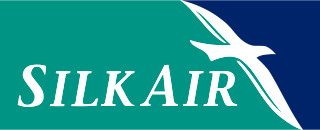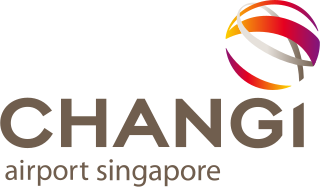
Singapore Airlines is the flag carrier of Singapore with its hub located at Changi Airport, and a member of the Star Alliance. The airline is notable for highlighting the Singapore Girl as its central figure in the corporate branding segment. Widely renowned as one of the best carriers, the airline is ranked as a 5-star airline by Skytrax, and it has also been ranked as the world's best airline five times. The airline operates a variety of Airbus and Boeing aircraft, namely the A350, A380, Boeing 737, Boeing 747 Freighter, Boeing 777 and Boeing 787.

SilkAir Singapore Private Limited, operating as SilkAir, was a Singaporean airline with its head office in Changi, Singapore. It was a wholly owned subsidiary of Singapore Airlines and in 2017, operated scheduled passenger services from Singapore to 54 cities in Southeast Asia, the Indian subcontinent, East Asia, and Northern Australia. As the regional wing of Singapore Airlines, it served the short to medium-haul destinations in the Singapore Airlines Group network.

Gold Coast Airport is a domestic and international Australian airport located at the southern end of the Gold Coast and approximately 90 km (56 mi) south of Brisbane, within the South East Queensland agglomeration. The entrance to the airport is situated in the suburb of Bilinga near Coolangatta. The main runway itself cuts through the state borders of Queensland and New South Wales. During summer, these states are in two different time zones. The Gold Coast Airport operates on Queensland Time.

SATS Ltd. (SATS), an acronym derived from Singapore Airport Terminal Services, is a Singaporean airport service company that handles the main ground handling and in-flight catering service provider at its country's Changi Airport. SATS controls about 80% of Changi Airport's ground handling and catering business.
Jetstar Asia Airways Pte Ltd is a Singaporean low-cost airline headquartered at Changi Airport. It operates services to regional destinations in Southeast Asia to countries such as Myanmar, Cambodia, Malaysia, Indonesia, Philippines, Thailand and Vietnam. It also flies to regional routes in East Asia such as Japan, Taiwan and Hong Kong.

Tigerair Mandala was a low-cost carrier headquartered in Jakarta, Indonesia. It was founded in 1969, by members of the Indonesian military dictatorship, as a full service airline. In 2006, as part of the ongoing reforms following the dictatorship ending in 1998, the military was forced to sell Mandala Airlines, with the new owners converting it to a low-cost carrier. In January 2011, facing bankruptcy, Mandala Airlines filed for protection from its creditors, and ceased operations. In May 2011, Singapore based Tiger Airways Holdings made an offer to purchase Mandala, but the transaction did not close until September 2011. The airline did not return to service until April 2012, renamed Tigerair Mandala, following an injection of fresh capital by Indonesian conglomerate Saratoga Investment Corp.

Cebgo, Inc., operating as Cebgo, is the regional brand of Cebu Pacific. It is the successor company to SEAIR, Inc., which previously operated as South East Asian Airlines and Tigerair Philippines. It is now owned by JG Summit, the parent company of Cebu Pacific which operates the airline. The airline's main base has been transferred from Clark International Airport in Angeles City to Ninoy Aquino International Airport in Metro Manila. On April 30, 2017, Cebgo planned to move out from Manila and transfer its main base to Mactan–Cebu International Airport in Cebu City because NAIA has already maxed out its capacity. Currently, it operates an all-ATR fleet, with a total of 16 in service.
QantasLink is a full-service, regional brand of Australian flag carrier Qantas and is an affiliate member of the Oneworld airline alliance. As of 2024, QantasLink provides over 2,000 flights each week to 61 metropolitan and regional destinations across Australia, as well as short-haul international services to New Zealand, Singapore, the Solomon Islands and East Timor.

Tiger Airways Australia Pty Ltd, operating as Tigerair Australia, was an Australian low-cost airline. Founded by Tiger Airways Holdings, it commenced services in the domestic airline market on 23 November 2007 as Tiger Airways Australia. It later became a subsidiary of Virgin Australia Holdings. On 25 March 2020, Tigerair suspended all operations as a result of the COVID-19 pandemic. Following Virgin Australia Holdings going into voluntary administration and later sold, new owner Bain Capital confirmed the brand would be retired.
Singapore Airlines Flights 21 and 22 are airline routes operated by Singapore Airlines between Singapore Changi Airport (SIN) and Newark Liberty International Airport (EWR). They were the two longest regularly scheduled non-stop flights in the world, until surpassed by Singapore Airlines Flights 23 and 24 between Singapore Changi Airport and John F. Kennedy International Airport (JFK) in November 2020.

Tiger Airways Holdings Limited was a Singapore-based airline holding company for a group of low-cost carriers operating in the Asia-Pacific region. It was formed in 2007 to allow for easier management of the airline subsidiaries, as well as any future expansion, without having to focus on operational issues, leaving those to the airlines themselves. In 2016, Singapore Airlines purchased the company and it was delisted from the Singapore Exchange.

Singapore Changi Airport, commonly known as Changi Airport, is a major international airport that serves Singapore, and is one of the largest transportation hubs in Asia. As one of the world's busiest airports by international passenger and cargo traffic, it has been rated as the "World's Best Airport" by Skytrax a dozen times, and was the first airport in the world to hold the accolade for eight consecutive years. It has also been rated as one of the world's cleanest airports and highly rated international transit airports. More than 100 airlines operate from the airport, with nonstop or direct flights to destinations in Asia, Oceania, Africa, Europe, the Middle East, and North America.
Virgin Australia Regional Airlines is an Australian regional airline based in Perth, servicing key towns in the state of Western Australia. The airline also flies interstate to destinations such as Adelaide, Darwin, Melbourne and Alice Springs. Formerly known as Skywest, in April 2013 the airline was purchased by Virgin Australia Holdings as its new regional offshoot. On 21 April 2020, Virgin Australia Regional Airlines' parent company, Virgin Australia Holdings went into voluntary administration due to the COVID-19 pandemic.

Scoot Pte Ltd, operating as Scoot, is a Singaporean low-cost airline and a wholly owned subsidiary of Singapore Airlines. It began its operations on 4 June 2012 on medium and long-haul routes from Singapore, predominantly to various airports throughout the Asia-Pacific region. Scoot's airline slogan is Escape the Ordinary.

Tigerair Taiwan is a low-cost airline based at Taoyuan International Airport. It was formed as a joint venture between China Airlines Group (80%), Mandarin Airlines (10%) and Tiger Airways Holdings (10%). In 2017, China Airlines acquired the 10% shares held by Budget Aviation Holdings after Tigerair Singapore has merged with Scoot. Tigerair Taiwan is the only LCC in Taiwan following the collapse of TransAsia Airways and V Air in 2016 and also the only airline left with Tigerair branding, after Tigerair Australia ceased operations in March 2020.

Tata SIA Airlines Limited, operating as Vistara, is an Indian full-service airline, based in Gurgaon (Gurugram), with its hub at Indira Gandhi International Airport. The carrier, a joint venture between Tata Sons and Singapore Airlines, commenced operations on 9 January 2015 with its inaugural flight between Delhi and Mumbai. The airline had carried more than two million passengers by June 2016 and as of April 2023, has an 8.7% share of the domestic carrier market, making it the 2nd largest domestic airline, behind IndiGo. The airline serves 50 destinations with a fleet of Airbus A320neo, Airbus A321neo and Boeing 787-9 aircraft.

Changi Airport is Singapore's primary international airport and a major aviation hub in the Asia-Pacific region. It is one of the commercial airports in Singapore, the other being Seletar Airport. Since the rankings for the World's Best Airport by Skytrax began in 1999, the airport was classified as the world's best twelve times, including for eight consecutive years from 2013 to 2021.

This article explores the history of Singapore Airlines, the flag carrier of the Republic of Singapore and based at the Singapore Changi Airport. Singapore Airlines, also known by its abbreviations of SIA or SQ, has often been ranked throughout its history as either amongst the best or the best airline in the world.

Singapore Airlines is majority-owned by Singapore government investment and holding company Temasek Holdings which holds 56% of voting stock.

















